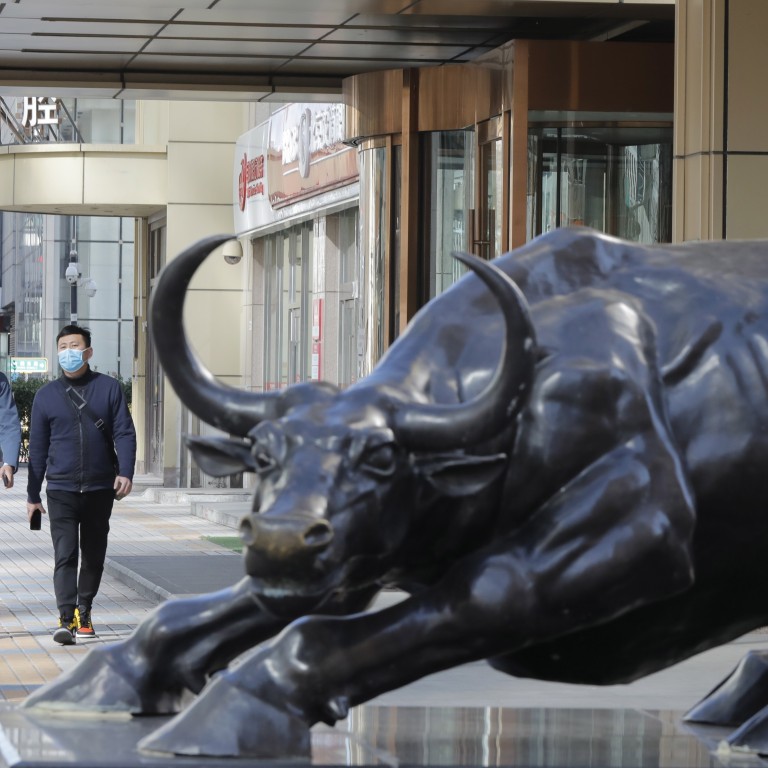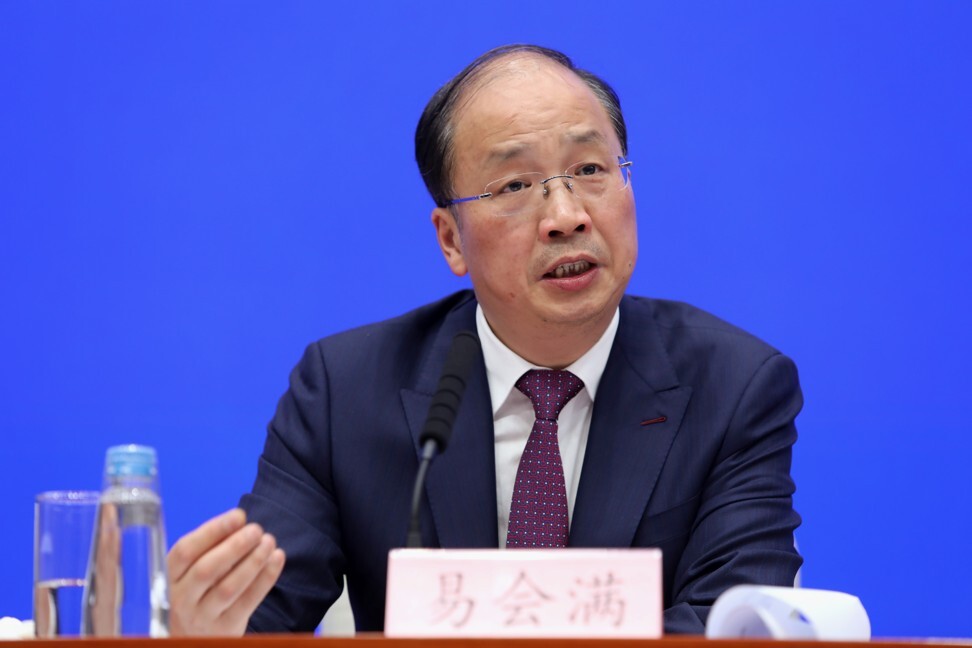
China’s world-beating stock bull run unleashed by economic recovery and liquidity sparks fears of another 2015 meltdown
- The value of Asia’s largest stock market increased by US$1 trillion – an amount larger than the Dutch economy – in the past three weeks
- The frenzy reminds some observers of the 2015 run-up – also fuelled by liquidity and valuation expansions – which ended in a US$5 trillion wipeout
When Yi Huiman took over the helm of China’s securities watchdog 18 months ago, pundits in the nation with 166 million stock trading accounts saw the auspiciousness of his name and cheered.
“Easy” and “bountiful” are the propitious promises symbolised by the name – in Chinese characters -of the former banker, who spent 34 years working his way to the very top of China’s most valuable lender before being hand-picked to oversee the stock market. Yi, a trained statistician, did not disappoint.
Explanations for the spectacular rally in China’s stock market – the major indices came close to, but never did fall into bear territory throughout this year’s coronavirus pandemic – run the gamut from the arcane and conspiratorial to the geopolitical and macroeconomic. One thing that analysts, fund managers, brokers and traders can agree on is that they have not seen so much wealth being created so quickly for a very long time.

The easiest explanation points to China’s economic recovery, shown by the 3.2 per cent second-quarter growth that handily beat expectations, as consumption, investments, manufacturing and trade resumed in the world’s second-largest economy. Global funds, in search of higher returns in a world of zero interest rates, rushed into yuan-denominated assets in China, the first major economy to enter into, and emerge out of, a months-long lockdown during the Covid-19 pandemic.
“China’s equities are rallying on the back of improving economic fundamentals. With the [coronavirus] under control domestically and short-term indicators of overseas economies showing signs of bottoming out, investors’ confidence in the A-share market continues to pick up,” said Zhu Chaoping, a global market strategist at JPMorgan Asset Management in Shanghai. “Another contributing factor is liquidity. The large-scale quantitative easing policies of overseas central banks have made global liquidity abundant.”
Newcomers have swollen the ranks of China’s investing hordes, boosting the number of A-share account holders by 18 per cent since Yi’s appointment to 166 million, making the country ruled by the Communist Party the world’s most populous capitalist market.
Money flooded into exchange-traded funds (ETFs), with 665 billion yuan (US$94.9 billion) sold in the first six months of 2020, more than what was sold in the whole of last year.
Unprecedented easing by global central banks has also spurred inflows of foreign capital. Global fund managers have spent 157.6 billion yuan buying Chinese stocks through a cross-border investment channel in Hong Kong so far this year, extending the purchase of 351.7 billion yuan for the whole of 2019.
The frenzy has brought back memories of a similar boom-to-bust cycle in 2015, when the Shanghai Composite Index more than doubled within half a year before tumbling more than 40 per cent over two months in a rout that wiped out US$5 trillion in value. The effects of the 2015 market rout are still being felt in China, with hundreds of indebted companies, fund management firms, brokers and investors struggling to work their way out of the financial mess five years later.
Some investors say the two run-ups share a trait: buoyant sentiment bolstered by ample liquidity and surging valuations, instead of earnings growth. The People’s Bank of China cut the benchmark interest rates six times in a year, starting in November 2014, while aggregate financing has risen to an all-time high this year and a measure of broader money supply has also grown at the fastest pace in two years.
Such confidence wouldn’t need much to undermine, or for the market’s upwards trajectory to derail, warned China Renaissance Holdings’ head of macro and strategy research Bruce Pang in Hong Kong.
“A sentiment-driven market is very fragile,” he said. “Market sentiment [towards Chinese stocks] is on edge and vulnerable to negative news flows, such as a renewed virus surge, slow macro recovery and geopolitical risks. High valuations support our view of an unsustainable rally.”
The stakes are particularly high for China, where limited options to short-selling turn the entire stock market into a one-way bet; and the higher stock prices go, the harder the crash when the downturn comes. At a time of rising unemployment and mass fatalities from the coronavirus pandemic, the Chinese government is particularly anxious to stave off any social instability from a market tumult.
The bull market rally stumbled this week, as state media waded in to slow its stampede. The Communist Party’s mouthpiece newspaper People’s Daily poured scorn on Kweichow Moutai, the world’s 20th-most valuable company, singling out the distillery for producing the exorbitant liquor that was often found in corruption cases. Moutai’s stock fell by as much as 8.7 per cent on Thursday in Shanghai, a US$25 billion wipeout in valuation that set the tone for 95 per cent of stocks to follow in decline.
Still, some argue that the bull run of 2020 will be more sustainable because of the more solid economic fundamentals.
China’s economy bounced back in the three months ended June, recovering from its first-quarter contraction of 6.8 per cent. The second-largest economy on the planet is the only major growth area while the world is still mired in lockdowns and slumps.

Whether the rally will carry on hinges on the strength of the recovery going forward, said Michelle Qi, chief investment officer at Eastspring Investments.
“Given current market valuations are already around the historical average level, we see policy easing largely priced in,” she said. “Further market upside would come from continued improvement in the economy and corporate earnings.”
The Shanghai Composite Index, mostly dominated by bigger companies engaged in the traditional industries, was valued at 13.4 times estimated earnings this year, 3.3 percentage point lower than the 2015 peak, according to Bloomberg data.
The multiple for the ChiNext gauge of smaller companies, the best performer among all Chinese onshore stock measures this year, hit an almost five-year high of 44 times this week.
Investors should be particularly cautious about Chinese small-caps that have made sizeable gains this year and look for opportunities in cheaper Hong Kong-traded companies that also have mainland listings, according to Alexious Lee at Jefferies Financial Group.
Star Market shoots into second place globally amid Chinese stocks euphoria
Chinese stocks with dual listings were 36 per cent more expensive than the Hong Kong-traded ones this month, the widest price gap in 17 months, according to a Hang Seng gauge tracking the difference between the two markets.
Regulators are moving to prevent the formation of a stock bubble which, if it burst, would eventually leave millions of small investors scathed.
With Yi at the helm, the China Securities Regulatory Commission (CSRC) started last week to crack down on over-the-counter margin financing by publishing a list of 258 institutions that were illegally funding leveraged stock buying. The CSRC chairman was not available for an interview.
A few days later, Vice-Premier Liu He arranged a top-level meeting of financial regulators, calling for a zero-tolerance approach to accounting fraud among publicly traded companies, and stricter delisting rules. The banking regulator issued a circular on Tuesday night requiring scrutiny of the shadow banking sector to prevent funds from illegally entering the stock market.
A short-term mentality geared towards quick gains was bound to emerge given the current set of conditions, according to Bocom International Holdings’ Hong Kong-based managing director, Hong Hao.
“In a market where liquidity has started to flow and the future remains uncertain, it is only rational to expect traders to speculate rather than focusing on the long term,” said Hong, one of the few strategists who accurately gauged the peak of 2015’s run-up while everybody else was rushing into the market.
The momentum of China’s stock market is not stopping any time soon because equities are still attractive, compared with the low yields on fixed-income financial products such as bonds, he said.
“There will be bumps on the road, and the attitude from the top is likely to dictate the tempo of the bull run,” Hong said.


